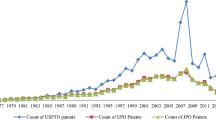Abstract
The aim of this study is to reveal the possible linkage among the 40 primary organizations in Genetic Engineering Research by taking the Patent Coupling approach. The primary organizations were defined by the productivity and identified by the patent count and Bradford Law. The author analyzed the cited patents of the patents granted by United States Patent and Trademark Office (USPTO) from 1991 to 2002 to the 40 primary organizations (assignees) in Genetics Engineering Research to establish the correlation.
780 coupling pairs formed by the 40 primary organizations and Coupling Index and Coupling Strength were calculated for each pair and primary organization. Correlation Analysis and Multiple-Dimension Scaling were applied further based on Coupling Index. Technological clusters were found in the results of the analyses.
Similar content being viewed by others
References
Albert, A., Plaza, L. M. (2004), The transfer of knowledge from the Spanish public R & D system to the productive sectors in the field of biotechnology. Scientomeric, 59(1): 3–14.
Banerjee, P., Gupta, B. M., Garg, K. C. (2000), Patent statistics as indicators of competition: an analysis of patenting in biotechnology. Scientometrics, 47(1): 95–116.
Bellardo, T. (1980), The use of co-citations to study science. Library Research, 2(3): 231–237.
Carpenter, M. P., Cooper, M., Narin, F. (1980), Linkage between basic research literature and patents. Research Management, 23: 30–35.
Cawkell, A. E. (1976), Understanding science by analyzing its literature. The Information Scientist, 10(1): 3–10.
Collins, P., Wyatt, S. (1988), Citations in patents to the basic research literatures. Research Policy, 17: 65–74.
Egghe, L., Rousseau, R. (1990), Introduction to informetrics: quantitative methods in library, documentation and information science. Elsevier Science Publishers, Amsterdam, Netherlands.
Garfield, F. (1998), From citation indexes to informetrics: is the tail now wagging the dog? Libri, 48: 67–80.
Garg, K. C., Padhi, P. (1998), Scientometric study of laser patent literature. Scientometrics, 43(3): 443–454.
Huang, Mu-hsuan, Chiang, Li-yun, Chen, Dar-zen (2003), Constructing a patent citation map using bibliographic coupling: a study of Taiwan’s high-tech companies. Scientometrics, 58(3): 489–506.
Jaffe, A. B., Fogarty, M. S., Banks, B. A. (1997), Evidence from patents and patent citations on the impact of NASA and other federal labs on commercial innovation (NBER Working Paper 6044). NBER, Cambridge, MA.
Kessler, M. (1963), Bibliographic coupling between scientific papers. American Documentation, 14: 10–25.
Kessler, M. M. (1965), Comparison of the results of bibliographic coupling and analytic subject indexing. American Documentation, 16(3): 223–233.
Lo, Szu-chia (2004), A Study of the Productivity of Genetic Engineering Research from 1991 to 2002 Using the Patentometrics Approach. Paper presented at International Workshop on Webometrics, Informetrics and Scientometrics & Fifth COLLNET Meeting, Roorkee, India.
Lo, Szu-chia, Huang, Mu-shuan (2005), Research impact on genetic engineering research: patent citation analysis. Poster presented at 10th International Conference of the International Society for Scientometrics and Informetrics, Post Session, Stockholm, Sweden.
Marshakova, I. V. (1979), Citation networks in information science. Scientometrics, 3(1): 13–26.
Moed, H. F. (2000), Bibliometric indicators reflect publication and management strategies. Scientometrics, 47(2): 323–346.
Narin, F. (1994), Patent bibliometrics. Scientometrics, 30(1): 147–155.
Narin, F. (1995), Patents as indicators for the evaluation of industrial research output. Scientometrics, 34(3): 489–496.
Rifkin, J. (1999), The Biotech Century: how genetic commerce will change the world. Phoenix, London.
Small, H. (1973), Co-citation in the scientific literature: a new measure of the relationship between two documents. Journal of the American Society for Information Science, 24(3): 265–269.
Viannen, B. G. Van, Moed, H. F., Raan, A. F. J. Van (1990), An exploration of the science base of recent technology. Science Policy, 19: 61–81.
Weinberg, B. H. (1974), Bibliographic coupling: a review. Information Storage and Retrieval, 10(5/6): 189–196.
Author information
Authors and Affiliations
Corresponding author
Rights and permissions
About this article
Cite this article
Lo, SC. Patent coupling analysis of primary organizations in genetic engineering research. Scientometrics 74, 143–151 (2008). https://doi.org/10.1007/s11192-008-0110-7
Received:
Published:
Issue Date:
DOI: https://doi.org/10.1007/s11192-008-0110-7




